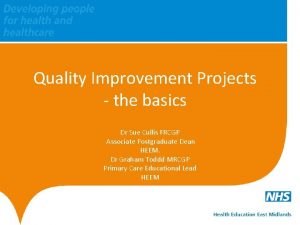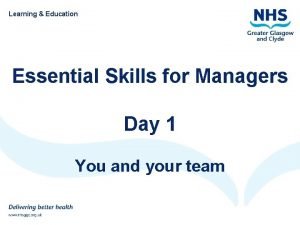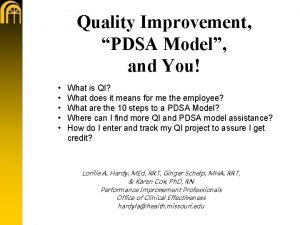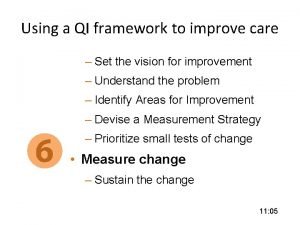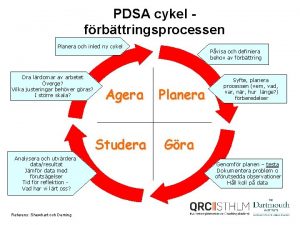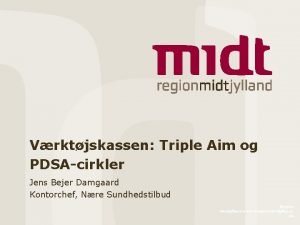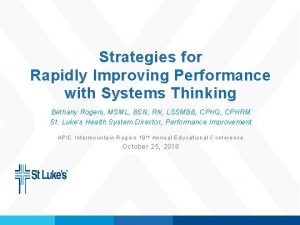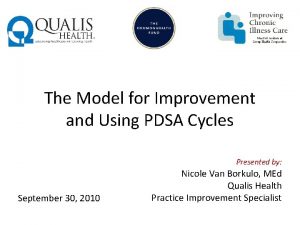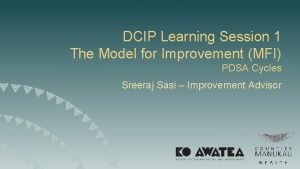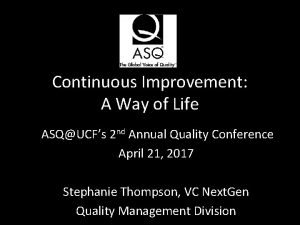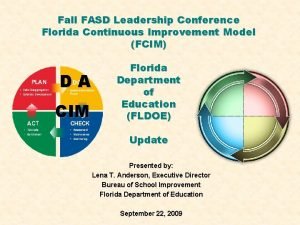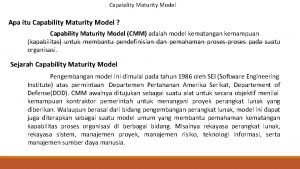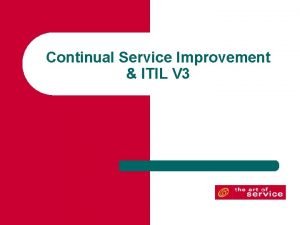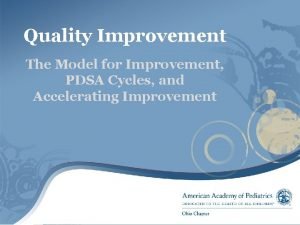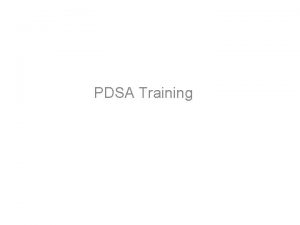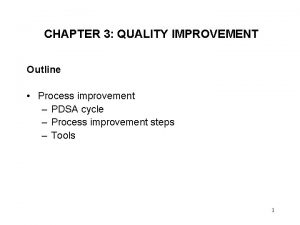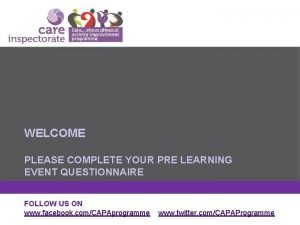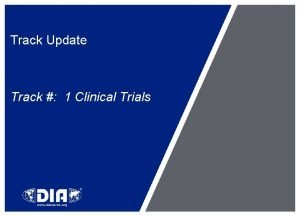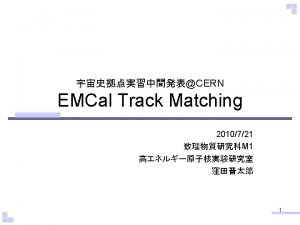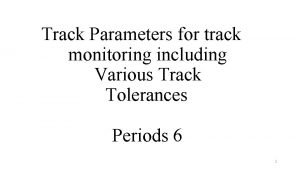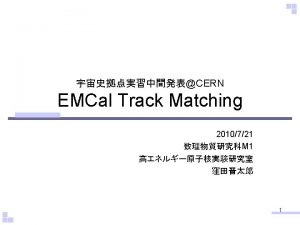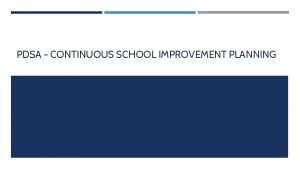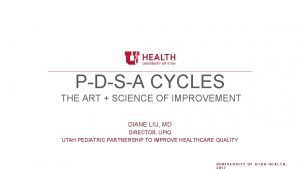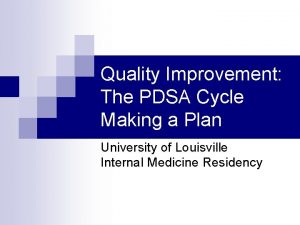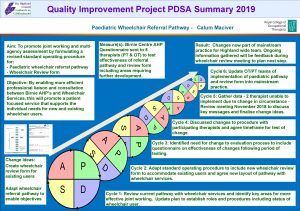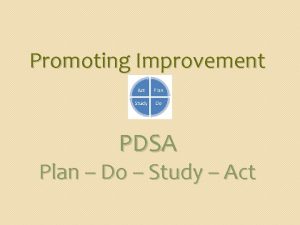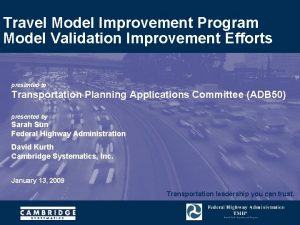Model for Improvement PDSA Spring Summit Foundations Track


































- Slides: 34

Model for Improvement (PDSA) Spring Summit – Foundations Track March 9, 2018

Objectives § Describe the importance of practice transformation. § Provide an overview of the Model for Improvement and the Plan, Do, Study, Act (PDSA) process. § Demonstrate the PDSA process and provide practical application. 2

Practice Transformation � Better Care for Individuals � Better Health for the Population � Lower Cost through Improvement � Improved Provider Satisfaction Source: The IHI Triple Aim framework was developed in 2007 by the Institute for Healthcare Improvement in Cambridge, Massachusetts (www. ihi. org) rmhp. org

The Work of Improvement § Quality Improvement needs to be the way we do things, not an added task or responsibility. § It is a priority, not an intrusion on “real jobs”. § “We have to get comfortable with discomfort because we will experience it frequently when we seek to change the status quo. ” Source: Studer, Q. (2003) Hardwiring Excellence. Firestarter Publishing, Gulf Breeze, FL. rmhp. org

The Model for Improvement rmhp. org Source: IHI – The model for improvement is adapted from Deming’s work and developed by Associates in Process Improvement

PDSA – Plan, Do, Study, Act § A method to test a change and asses its impact. § Breaks down change into manageable, bitesized, time-limited chunks. § Minimizes risks and expenditures of time and money rmhp. org

Aim Statements include: § What are we trying to accomplish? § Why is it important? § Who is the specific target population? § When will this be completed? § How will this be carried out? § What is/are our measurable goal? rmhp. org

Set SMART Goals § Specific § Measurable § Achievable § Realistic § Time-phased rmhp. org

Aim Statement Examples § By May 2018, 25% of licensed child care providers in Mesa County will be trained in the "I am Moving, I am Learning" curriculum. § We will reduce the average wait time (non-value added time) from its current baseline of 32 minutes by 50% to 16 minutes, by June 2018. Case Study: We will improve our Hemoglobin A 1 c CQM for all patients in our practice; by May 30, 2018 we will decrease the percentage of patients with a Hemoglobin A 1 C greater than 9% or not measured during the prior year from 45% to 35%. rmhp. org

Plan § Recruit and identify the team § Draft an Aim statement § Describe current process PLAN § Identify data that will need to be collected rmhp. org

“Plan” for Measurement How will we know that a change is an improvement? q How will the data be used? q What are the data sources? Case Study: # patients not meeting measure, # of patients recalled and seen, # of patients tested at visit q Do you have baseline data? q Who is responsible for actually collecting the data? q How often and how long will the data be collected? rmhp. org

DO: Piloting Your Solution § Begin by making sure that people understand why a change is needed, and how to implement the solution to be piloted. § Carry out the test- DO IT! § Monitor the progress Case Study: Implement reminder system; outreach to poorly controlled or not tested patients; enroll patients in care management § Make sure the data you’ll need to evaluate success is collected. § Tip - Effective communication is especially important during change. DO rmhp. org

Study • Analyze your results by using your Aim Statement from the Plan and data gathered from the Do. • Complete analysis of the data. • In hindsight, what are the pro’s and con’s of your solution? Case Study: Did patient outreach increase measure compliance? How many patients >9% were enrolled in care management? • Do you believe this change can be sustained? STUDY • Summarize and reflect on what was learned rmhp. org

Act: The Next Steps • Reflect on your plan and the outcomes. • Adapt, Abandon or Adopt based on the analysis of the collected input and information. • Prepare and plan for the next test. ACT Case Study: Develop a registry, coordinate care management. rmhp. org

Act: The Next Steps If the change you piloted was successful: • Celebrate your success! • Take whatever steps are necessary to formalize the change and sustain your accomplishment. • Communicate accomplishments internally and externally If the change you piloted didn’t work out as intended: • Share the results. • Use the lessons learned to develop a new plan. • Begin another PDSA cycle ACT rmhp. org

Repeated use of the PDSA cycle Aim: By May 30, 2018 we will decrease the percentage of patients with a Hemoglobin A 1 C greater than 9% or not measured during the prior year from 45% to 35%. AC T DO AC T AN PL Introduce Diabetes Hg. A 1 C measure ST UD Y DO AC T AN PL ST UD Y DO D AN PL ata AC T DO ST UD Y AN PL AC T Registry and care management Cycle 5: Regular monitoring and follow-up Cycle 4: Develop standing orders Cycle 3: Implement pre-visit planning process Cycle 2: Identify patients with care gaps and conduct recalls Cycle 1: Validate the data rmhp. org

17

PDSA Exercise It is time to work…. . Copyright © 2014 True. Simple, LLC Williams, DM. Mr. Potato Head Plan, Do, Study, Act (PDSA) Exercise. Austin, TX: True. Simple, LLC. 2014. (Available on www. truesimple. com rmhp. org

Accuracy Score 3 points = All pieces are on & positioned correctly 2 points = All pieces are on, but one or more is out of place 1 point = One or more pieces are not on 19 rmhp. org

Debrief 20 rmhp. org

Process Mapping Spring Summit – Foundations Track March 9, 2018

What is a Process? • A series of steps • Inputs are transformed into outputs • Processes deliver the outputs they are designed to deliver! 22 rmhp. org

Process Mapping rmhp. org

Why Process Maps help us understand how a process works and understand how a process is done. • To study a process for improvement. • To communicate to others how a process is done. • When better communication is needed between people • To document a process. • When planning a project. 24 rmhp. org

Steps to Process Mapping • Focus on one process at a time and understand that process • Describe a process as it works today (current state) • Identify gaps, brainstorm, and create new workflows to close gaps • Complete PDSA cycles to test your new changes Act Plan Study Do • Once you achieve the end ideal end results, create a written work flow that can be used for training new staff rmhp. org

Swimlane 26 rmhp. org

Common process map symbols Process represents a step or activity in your process. Terminal points indicate the starting or ending points of a process. Delay represents a waiting period where no value-added activity takes place. Decision indicates a point where the outcome of a decision dictates the next step. There can be multiple outcomes, but often there are just two - yes and no. Preparation indicates an action that helps prepare for the next step in the process. Manual operation indicates an operation or adjustment to the process that can be made manually. Start & End Document represents a step that requires or results in a document. Kaizen bursts indicate improvement opportunities. rmhp. org

Connectors Solid lines are used to connect the flowchart symbols. Dotted lines indicate an alternate process. Arrow on both ends indicates that the process flow can move in either direction between the two steps. Arrow on one end indicates the direction of the process flow. rmhp. org

Example 1 NO Patient Roomed Patient over 65? Patient is a smoker? NO Patient NOT Eligible YES Patient Eligible for Vaccine 29 rmhp. org

Process Maps Daily Huddle – Current state 7: 45 Start Discuss dress. code Discuss new patients Discuss. vacation schedule Act Plan Study Do Discuss anticipated 8: 07 Finish needs Revised Daily Huddle 7: 45 Start Discuss staff assignment Discuss. available appts Discuss new. patients Discuss anticipated 7: 58 Finish. needs rmhp. org

Tips and Tricks • Detail • Facilitation • Real flow representation • Stakeholders • Clarity • Consistency of flow 31 rmhp. org

Creating a Process Map • Excel • Word • Visio • Smartchart 32 rmhp. org

Exercise – Process Mapping rmhp. org

Debrief 34 rmhp. org
 Pdsa model nhs
Pdsa model nhs Pdsa model nhs
Pdsa model nhs Pdsa template
Pdsa template A ball is held above the ground and then is dropped
A ball is held above the ground and then is dropped Spring summer fall winter and spring cast
Spring summer fall winter and spring cast Autumn is yellow winter is white
Autumn is yellow winter is white Pdsa worksheet
Pdsa worksheet Apa itu konsep pdca
Apa itu konsep pdca Rampa de pdsa
Rampa de pdsa Pdsa cycles
Pdsa cycles Pdca cykel
Pdca cykel Pdsa cirkler
Pdsa cirkler Pdsa sirkel
Pdsa sirkel Pdsa exemplo
Pdsa exemplo Pdsa cycle in healthcare
Pdsa cycle in healthcare Pdsa sirkel
Pdsa sirkel Pdsa
Pdsa Pdsa falkirk
Pdsa falkirk Pdsa
Pdsa Ucf pdsa
Ucf pdsa Rapid improvement model
Rapid improvement model Florida continuous improvement model
Florida continuous improvement model Apa itu cmmi
Apa itu cmmi Continual service improvement metrics
Continual service improvement metrics Rapid cycle improvement
Rapid cycle improvement Fspos
Fspos Novell typiska drag
Novell typiska drag Tack för att ni lyssnade bild
Tack för att ni lyssnade bild Ekologiskt fotavtryck
Ekologiskt fotavtryck Varför kallas perioden 1918-1939 för mellankrigstiden
Varför kallas perioden 1918-1939 för mellankrigstiden En lathund för arbete med kontinuitetshantering
En lathund för arbete med kontinuitetshantering Kassaregister ideell förening
Kassaregister ideell förening Personlig tidbok fylla i
Personlig tidbok fylla i A gastrica
A gastrica Förklara densitet för barn
Förklara densitet för barn
